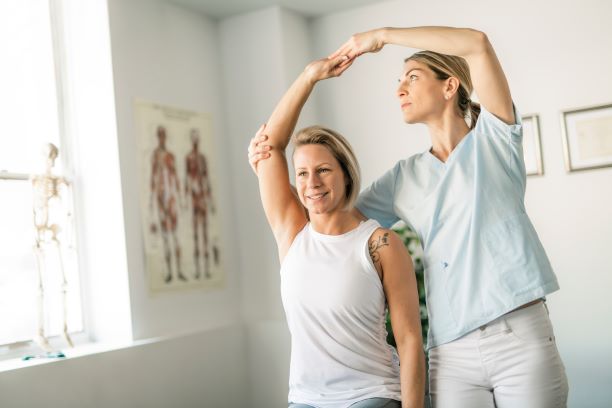Rotator cuff repair surgery involves stitching the tendon back to the tendon or tendon back to the bone. This requires caution for the first 3 to 6 months after surgery. Your repair is vulnerable to re-tearing. Overly aggressive stretching or lifting of your arm will damage the repaired tendon. The exercises included in this article are a safe progression of the early phase range of motion exercises done during your rotator cuff surgery recovery.
Rotator Cuff Surgery Recovery is a Marathon
You must remain patient throughout the process in order to achieve the best results. Your second phase of rehabilitation begins around 6 weeks after surgery. However, if you had a larger tear that requires greater protection this will be delayed further.
Phase 2 exercises use less external assistance than those performed in phase 1. This leads to slightly greater activation of your rotator cuff muscles but do so in a protected fashion. The goals of phase 2 are to restore your range of motion and prepare your shoulder muscles for gentle strengthening exercises down the road.
Incline Table Slides
This exercise is a progression of the table slide exercise performed in the early phases of rehabilitation. Begin standing, holding a towel with your hand resting on a surface inclined about 45 degrees. Relax your shoulder and neck muscles. Slide your hand up the incline. At the top, hold for 2 to 3 seconds. Perform 10 to 15 repetitions for 2 to 3 sets.
Wall Slides
This exercise is a progression of the incline table slide. Here you transition towards raising your arm overhead. Begin standing, holding a towel with your elbow bent. Relax your shoulder and neck muscles. Slide your hand up the wall. At the top, hold for 2 to 3 seconds. Lower your arm under control. Slowly slide back down the wall. Initially, your uninvolved hand can be used to assist the movement. As pain decreases and strength improve, perform the exercise unassisted.
Active Press-Up in Supine
Lie on your back with your knees bent. Your arm begins to your side with your elbow bent. Actively lift your arm straight up to the ceiling. This is like a bench pressing movement. When your elbow reaches full extension, pause and hold the position for 2 to 3 seconds. Perform 10 to 15 repetitions for 2 to 3 sets. This exercise can be safely progressed by performing it in a slightly reclined position and eventually in standing.
Wand-Assisted Flexion in Supine
Lie on your back holding a cane, wand, or similar straight object. Space your hands slightly wider than shoulder-width. Grasp the cane or wand between your thumb and index finger. Assume a thumb-up position. The thumb-up position will maximize movement at your shoulder joint. With both elbows straight, lift your arms overhead until a mild to moderate stretch is felt. Hold this position for 5 to 10 seconds. Then slowly lower back to the start position. Perform 10 to 20 repetitions.
Resistance Band Elevation in Supine
Performing exercises lying on your back minimizes the effect of gravity. This makes it ideal to begin exercising with light resistance while protecting your healing rotator cuff repair.
To perform band elevation, begin on your back. Hold a resistance band in your hand at waist level. Start your shoulder flexed at 90°. Straighten your elbow holding the band in a thumb-up position. Put minimal tension on the band in the starting position.
Actively lift your arm to approximately 160°, thereby lengthening the band. Pause 2 to 3 seconds at the top, then lower slowly back to the starting position. Perform 10 to 15 repetitions for 2 to 3 sets.
Closing Thoughts on Rotator Cuff Surgery Recovery
From the 6 to 12-week point after your rotator cuff surgery, you will feel much less pain. Beware! This can provide a false sense of security. Your repaired tendon is still at only approximately 25% to 50% normal strength during this time period.
Exercise must still be applied cautiously. Your physical therapist and surgeon will communicate with each other to determine the optimal rate of progression for you. If you remain patient and consistent with your exercises you will be happy with the end result.
If you are looking for more help, call our office to schedule an appointment. Our doctors of physical therapy have been helping people in Southern Ocean County move without pain for more than 15 years.


